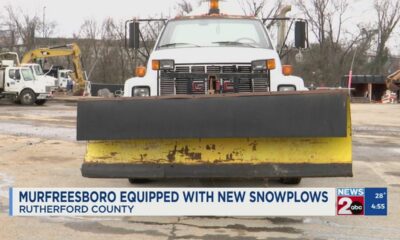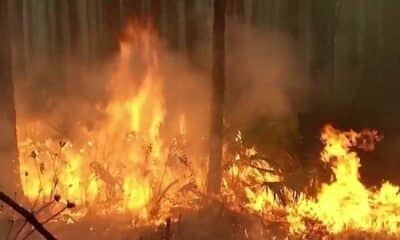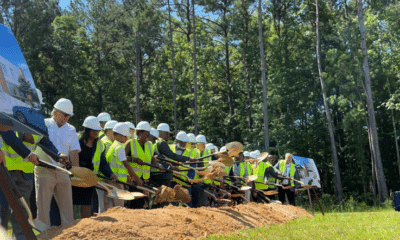News from the South - North Carolina News Feed
If you’re sick of seeing Helene debris everywhere, brace yourself. It’s going to be here for far longer than you want • Asheville Watchdog
There’s just no nice way to say this: We’re still looking pretty rough these days.
Western North Carolina, I mean. And yes, thanks to Helene.
Sure, a blanket of snow over the weekend helped with the aesthetics a bit, but we’ve still got a pretty bad tropical storm hangover. Debris remains everywhere, ranging from piles of tree branches to cars in rivers.
A recurring theme in my correspondence with readers is their frustration with the slow rate of storm debris cleanup. Everywhere. Here’s one sample, from my email:
“Is Swannanoa now the new dumping yard and general eyesore for Buncombe County? Three months since Helene, yet Swannanoa looks and feels eerily like the disaster area it has been since Sept 27, 2024. Other areas are being picked up, put back together. Meanwhile, Swannaona resembles essentially what it did a week after Helene hit.”
I’ve heard the same complaints about Biltmore Village, the French Broad River north of town, the Swannanoa River pretty much everywhere, the River Arts District, north Asheville, and several parts of Buncombe County.
The readers are right — parts of our community still look pretty rough. Heck, in my neighborhood a few houses still have furniture, mattresses, and paint cans sitting at the curb, waiting for some mysterious entity to pick them up.
More than three months after Helene, debris cleanup remains agonizingly slow. I hate to say this, but it’s not going to get a whole lot faster. Cleanup is going to take months, probably even years in places.
I will say this: Asheville and Buncombe officials have been very upfront about this from the get-go. Buncombe County Manager Avril Pinder and Asheville City Manager Debra Campbell have made frequent appearances at the regular Helene briefings, giving updates on storm cleanup, and they always mention how much debris has been cleared and how many trucks and crews are on the road.
A mind-bending amount of debris remains
And they always mention that millions of cubic yards of debris remain.
At the last briefing Jan. 9, Pinder noted that “694,384 cubic yards of debris have been removed from the public right of way.
“That’s in Buncombe County, Black Mountain, and the City of Asheville,” Pinder said. “Today, there are 34 trucks running in Buncombe County for right-of-way collection. There are 26 tree crews operating in the county. And debris crews are currently active at Lake Julian Park.”
The city and county have maintained since the storm that Buncombe has about 10 million cubic yards of debris that needs to be cleared. That includes about 3 million cubic yards in the city proper.
If you do a little extrapolation — say, calculate that they’re picking up 650,000 cubic yards every three months, or about 217,000 a month — that comes out to about 2.6 million cubic yards a year.
That would mean four years of looking at debris piles. I don’t think removal is going to take that long, but it’s not going to be fast, either.
I asked Pinder on Thursday if that extrapolation holds true.

“I think it’s going to take several, several more months to pick up all the debris,” Pinder said. “And what we did say today, as well, is that we are at about 95 percent of that first pass. We talked about several passes to pick up all the debris.”
People are now bringing out second piles of debris, as they continue to clean out their homes and yards.
“As we’re going back through now and surveying our streets, we’re seeing new debris on the site as well,” Pinder said. “So we know it’s going to take multiple passes. We ask people not to bring too much to overcrowd it right away, and we’re seeing that that second wave is starting now.”
Swannanoa and Barnardsville have had about 95 percent of the first wave picked up, Pinder said, and the other parts of the county stand at 99 percent. But that second wave is considerable, too.
Crews have not started removing ruined “titled property” — cars, boats, trucks. The goal is to get that started by mid-February, Pinder said.
As a reminder, Pinder again explained how this system works.
“We actually have the United States Corps of Engineers doing a collection for us on debris, and that’s the contract through FEMA,” Pinder said. “And then they then subcontract to our local vendors.”
Keep in mind that these contractors also are working in several other mountain counties where debris remains.
Can more resources be brought to bear?
I asked if the county could request more trucks and more crews. Pinder said it has “really ramped up the staffing and subcontractors” doing this work.
“They have been bringing more trucks,” Pinder said. “And I would ask that question too — if there are more trucks that they can bring, but they have brought as many trucks as possible, I think, in our community,” Pinder said. “But we can ask that question again to see if there’s any more that they can bring to our community.”
In its Jan. 8, newsletter, FEMA noted: “More than 2.6 million cubic yards of debris has been removed from public rights of way by FEMA and the U.S. Army Corps of Engineers and contractors.” That’s a big number but that’s not just Buncombe, of course.
The FEMA North Carolina news desk told me Friday that the Army Corps is currently picking up debris in 10 cities, towns, or counties. FEMA and the state are conducting debris removal in the remaining counties affected by Helene, FEMA said.
I asked about adding more crews, and a timeline.
“More contractors, crews, and trucks can at times only increase congestion and illuminate pinch points along the routes and into/out of staging and reduction sites,” the FEMA news desk said. “To keep from overtaxing infrastructure, debris contractors work with local officials on collection routes and priority areas.”
Regarding a timeline, FEMA said, “There is no exact date for when debris removal will end. Usually after large disasters, it is common for removal to continue for several weeks or months after an event.”
I’ve also asked the city about debris pickup slowness, and city spokesperson Kim Miller responded.
“We understand our community’s frustration with storm debris removal,” Miller said. “The initial assessment shows up to 3 million cubic yards of storm debris in the city — equivalent to roughly 140 football fields stacked 10 feet high.”
She noted that efficient debris removal “requires careful sorting and processing, which takes time.
“Please continue to leave storm-related debris curbside,” Miller said. “Teams are out collecting debris daily. We are unable, at this point in recovery, to specify streets or times of pickups.”
The county and city also offered tips for keeping debris removal efficient. Here are a few to keep in mind:
- Debris may be blocked by parked cars or overhanging power lines. Some piles, such as those under power lines or behind parked cars, require smaller equipment like skid-steers.
- Piles placed outside the right-of-way (beyond 10 feet from the road) cannot be collected.
- Trucks are limited by the type of debris they can collect during each pass. For example, if a truck is collecting vegetation, it cannot pick up construction or mixed debris.
- Crews are making multiple passes and will continue working until all debris in the public right-of-way is cleared. The first pass focuses on readily accessible debris. Ensure your debris is sorted, unobstructed, and within the right-of-way.
The county is still asking people not to take vegetative debris to the landfill, as it’s trying to keep that out of there and grind it up separately.
When I asked FEMA about complaints from readers about spotty debris pickup, the news desk also stressed putting the debris in the right of way.
“Some debris removal was ineligible due to the fact that private insurance made or were in the process of making arrangements to remove that debris,” FEMA said, noting you should contact local officials if you feel you were skipped over.
Before Christmas, I wrote an Answer Man column answering a question about waterway cleanup. That also falls to the Army Corps of Engineers, under direction from FEMA, and Army Corps spokesperson David Connolly also invoked the long-haul nature of this enterprise.
We’re looking at months and months of cleanup time, at least.
The complexities of waterway debris cleanup
“If you think right-of-way debris removal is complicated, waterway gets that much more complicated,” Connolly said then. He also noted that the Corps has similar cleanups to do in 10 to 15 mountain counties.

So those cars and trucks in the Swannanoa River that are visible from Thompson Street? They’re not going anywhere soon.
Connolly said steps for waterway cleanups include receiving applications for the work, verifying the need through reconnaissance and then assembling a detailed plan that includes definitions of where the waterway in question begins and ends. The Corps also has to determine where the proper points of entry will be.
When asked for a timeline, Connolly answered with brutal honesty.
“I honestly can’t. I won’t even pretend to speculate on that right now,” Connolly said. “I wouldn’t want to give people some false hope of a timeline, because I really just don’t have one.”
I can tell you from talking to property owners that removal and rebuilding damaged buildings gets really complicated. They have to wrangle with insurance companies and banks, figure out if their buildings are salvageable and arrange for reputable contractors to do the work.
In some cases, they’re unsure if they can rebuild in a floodplain or meet newer codes that call for sites to be raised.
All of this is just more complicated than it appears it should be.
That’s frustrating and depressing for all of us, especially in winter when all of the vegetation and leaves are gone. We’re exposed in many ways right now, and it’s not pretty to see.
One of the charms of this area is the natural beauty, the streams and rivers and beautiful vistas that we’ve all taken for granted for so long. It’s tough to see it besmirched.
For now, we all have to be patient, follow the recommendations, and do what we can to help others out.
Meanwhile, it’s not going to be pleasant to look at.
Asheville Watchdog is a nonprofit news team producing stories that matter to Asheville and Buncombe County. Got a question? Send it to John Boyle at jboyle@avlwatchdog.org or 828-337-0941. His Answer Man columns appear each Tuesday and Friday. The Watchdog’s reporting is made possible by donations from the community. To show your support for this vital public service go to avlwatchdog.org/support-our-publication/.
Related
The post If you’re sick of seeing Helene debris everywhere, brace yourself. It’s going to be here for far longer than you want • Asheville Watchdog appeared first on avlwatchdog.org
News from the South - North Carolina News Feed
Over a third of Americans are on TikTok. That could change in a week. • NC Newsline
SUMMARY: The Supreme Court heard arguments on January 10 regarding a federal law that could force TikTok to either be banned in the U.S. or have its Chinese parent company sold to non-Chinese owners. TikTok argues this law violates First Amendment rights, while the government cites national security concerns. A recent Pew survey shows only 32% of Americans support a ban, down from 50% earlier. TikTok, popular among younger users, has become a significant news source. The case stems from the 2024 Protecting Americans from Foreign Controlled Applications Act, aimed at apps from countries identified as foreign adversaries.
The post Over a third of Americans are on TikTok. That could change in a week. • NC Newsline appeared first on ncnewsline.com
News from the South - North Carolina News Feed
Could reservoir watersheds be used for recreational purposes? Why does Richmond Hill Park remain closed? Reduced hours at some Buncombe libraries? • Asheville Watchdog
Today’s round of questions, my smart-aleck replies, and the real answers:
Question: Now that many of us have newfound expertise regarding Asheville’s water supply, I’d like to pivot slightly and ask: What prevents the watersheds owned by the city of Asheville from being opened to limited recreation? Other city-owned watersheds and reservoirs, e.g. Canton and Greensboro, are available for limited use, so our closure seems not to be a requirement foisted by Raleigh. And the risk of contamination from day use, non-motorized recreation can’t be much higher than what’s already emitted by existing wildlife.
My answer: Well, we humans do have a history of treading ever so lightly on our recreational lands. It’s like you can’t even tell we were there, other than the bike tracks, portable toilets, throngs of tourists approaching wildlife with cell phone cameras, discarded dog poop bags, and a few hundred mountain bike ruts.
Real answer: I suspect it would take less than a week for some idiot to accidentally, or intentionally, start a fire in the watershed, and that is one of the considerations. More about that in a second.
Asheville Water Resources Department spokesperson Clay Chandler put the kibosh on this one pretty quickly. He said both the North Fork and Bee Tree treatment plants, in Black Mountain and Swannanoa, respectively, are both designated as “Water Supply-I.”
“That designation carries a lengthy list of regulations, but it essentially prohibits any kind of commercial development to protect the quality of the water flowing into our reservoirs,” Chandler said. “Asheville is unique in that the city owns the actual watersheds, so we’re able to implement a few regulations ourselves.”
Chandler said the reader is “probably correct” in that light use for recreation would not have any more impact than wildlife does.
“Our primary concern lies with fire risk,” Chandler said. “In its current condition, the amount of fuel on the forest floor from downed timber and other dead vegetation would allow even a small fire to spread quickly.”
A fire in the watershed would increase sediment runoff, could alter soil properties “due to things like ash clogging soil pores, and generally increase flood risk and decrease erosion control,” Chandler said. “That would obviously have an adverse effect on water quality.”
He cited the 2020 Cameron Peak fire in Colorado, which severely damaged the watershed.
That fire had a 32-mile long perimeter, burned more than 41,700 acres of wilderness and 32 miles of wild and scenic river corridor, and affected three watersheds. It also destroyed 492 structures.
The North Carolina Department of Environmental Quality notes that the state has five water supply classifications — Water Supply-I to Water Supply-V — “that are defined according to the land use characteristics of the watershed.”
“The Water Supply-I classification carries the greatest protection for water supplies,” DEQ states. “No development is allowed in these watersheds. Generally, WS-I lands arepublicly owned.”
By contrast, Water Supply-V watersheds “have the least amount of protection and do not require development restrictions. These are either former water supply sources or sources used by Industry.”

Question: We have been hiking at Richmond Hill Park for years. After Helene, someone or some group came out and cleared trees along all the paths so you could continue to hike. Now the park has been closed and the entrance is blocked. We are wondering what the issues are, and what is the outlook for reopening? Also, we’re wondering whether this is happening at other parks that are not along the river and really devastated.
My answer: I’d like to find this “someone or some group” to help with branch and debris cleanup in my yard. Please hook me up!
Real answer: City of Asheville spokesperson Kim Miller directed me to the city’s Parks & Recreation webpage, which in part states that if a park is listed as being closed, “PLEASE stay away.”
“Though some spaces look safe, there may be broken equipment, sinkholes, or other ‘unseen’ dangers following unprecedented damage from storms in September,” Parks & Rec states. “Disaster relief agencies continue to assess damage that may be eligible for grants and other recovery resources; unauthorized ‘help’ may make some parks ineligible for this vital funding.”

The city asks if you’re interested in volunteering to send an email to parks@ashevillenc.gov.
As of Monday, the city listed these parks as still closed: Azalea (including the John B. Lewis Soccer Complex), Carrier, French Broad River, Jean Webb (including Craven Street Bridge Boating Access Area), Recreation, Richmond Hill, Riverside Cemetery and the Wilma Dykeman Greenway.
The city notes that the cemetery is open to those attending services.
In addition, “Memorial Stadium and Mountainside Park are closed for community improvement projects unrelated to storm damage and should reopen soon,” the city states.
The city also noted that riverfront parks were the hardest hit, “with massive destruction left by this unprecedented event and are closed indefinitely.”
“While these spaces look devastated, they also represent the prospect of reimagining and rebuilding smarter, stronger, and in ways that make our city more resilient in the face of natural disasters such as floods,” the webpage states.
As far as organizing volunteer teams to help with the cleanup, the city notes that this gets more complicated than you might think, in part because, “disposal of storm debris is subject to strict federal and state regulations.”

Question: I was recently told that the Buncombe County commissioners are proposing to revise the library hours at certain facilities. Is this true? I really hope not, as I can say I know the manager of one of the branches being proposed for shortened hours, and they go in when the library is closed to process returns and holds because it is so busy when they reopen for the week.
My answer: I stopped working off the clock a while back, just as a matter of principle. OK, it was about 30 years ago. Seriously, you just shouldn’t do that.
Real answer: Unfortunately, some cuts in hours are on the horizon for the library system.
Buncombe County spokesperson Lillian Govus told me via email that the county has an anticipated revenue shortfall that could reach $20 million this fiscal year, which runs through June 30. As with most bad news these days, the shortfall comes from impacts of Tropical Storm Helene, Govus said.
The county already has implemented a hiring freeze on all positions, with the exception of those in 911 services.
“We are reopening Swannanoa Library for the first time since the storm on Jan. 25, which is great news,” Govus said. “However, we also have 14 vacancies in our libraries, so in order to keep all of our branches open, we’ve worked with library staff to develop a schedule that meets library demand but unfortunately, does reduce some hours in some locations.”
For full schedules of your library, go to the county’s news page on the issue.
“This is not a move that is intended to be permanent, and we’ll continue monitoring our regular recurring revenue projections,” Govus said, noting that the Board of Commissioners will hold a full-day budget meeting Thursday, available at www.facebook.com/buncombegov.
Govus noted that the decision is “a county operational adjustment, not anything that commissioners will vote on.”
Additionally, Library Services Director Jason Hyatt will join the community briefing at 11 a.m. Wednesday to share more information on this, Govus said.
Asheville Watchdog is a nonprofit news team producing stories that matter to Asheville and Buncombe County. Got a question? Send it to John Boyle at jboyle@avlwatchdog.org or 828-337-0941. His Answer Man columns appear each Tuesday and Friday. The Watchdog’s reporting is made possible by donations from the community. To show your support for this vital public service go to avlwatchdog.org/support-our-publication/.
Related
The post Could reservoir watersheds be used for recreational purposes? Why does Richmond Hill Park remain closed? Reduced hours at some Buncombe libraries? • Asheville Watchdog appeared first on avlwatchdog.org
News from the South - North Carolina News Feed
Trump and the latest climate change red flag • NC Newsline
SUMMARY: The article takes a politically left-leaning stance as it critiques President-elect Donald Trump’s continued denial of climate change, highlighting the worsening wildfires in California as evidence of the crisis. The author recalls California’s historical fires but notes how the situation has intensified due to climate change, with more fire days each year. Despite the undeniable evidence, Trump persists in blaming environmental regulations and promoting fossil fuel policies. The article warns that reversing progress on sustainable energy could worsen the crisis, urging politicians, especially Republicans, to prioritize the future over political gain. The author emphasizes that climate change is an urgent issue impacting health, economy, and security.
The post Trump and the latest climate change red flag • NC Newsline appeared first on ncnewsline.com
-

 News from the South - Arkansas News Feed6 days ago
News from the South - Arkansas News Feed6 days agoArkansas commission clears deputy in controversial arrest case
-

 News from the South - Alabama News Feed7 days ago
News from the South - Alabama News Feed7 days agoBaldwin County chaplain in New Orleans after terror attack
-

 News from the South - Florida News Feed7 days ago
News from the South - Florida News Feed7 days agoCNN defamation trial comes at a rough time for legacy media — and for the struggling network
-

 News from the South - Kentucky News Feed5 days ago
News from the South - Kentucky News Feed5 days agoMetal armored fighting takes over the cage this weekend in New Albany
-

 News from the South - Tennessee News Feed7 days ago
News from the South - Tennessee News Feed7 days agoMurfreesboro equipped with new snowplows
-

 Local News4 days ago
Local News4 days agoTrump sentenced to penalty-free ‘unconditional discharge’ in hush money case
-

 News from the South - South Carolina News Feed2 days ago
News from the South - South Carolina News Feed2 days ago24 dead as fire crews try to corral Los Angeles blazes before winds return this week
-

 Mississippi News Video5 days ago
Mississippi News Video5 days agoWintry mix expected in Mississippi this week. Here’s how to prepare




























